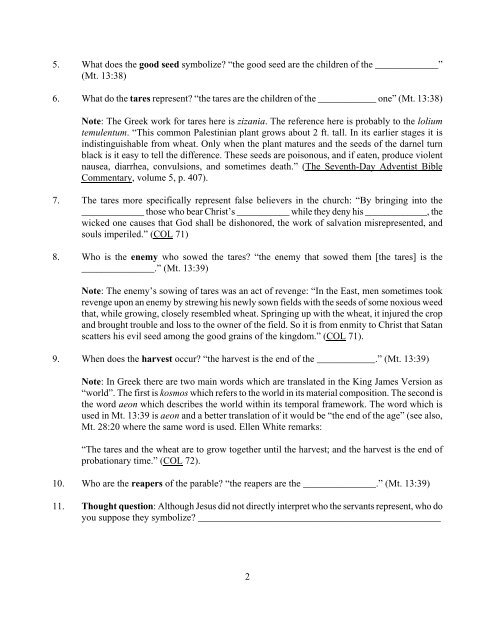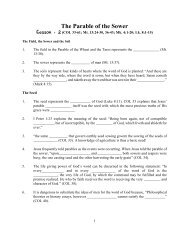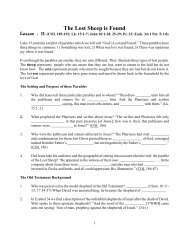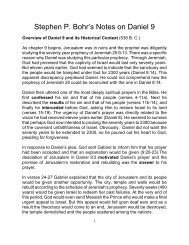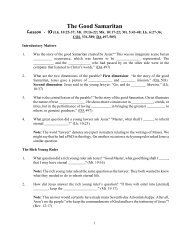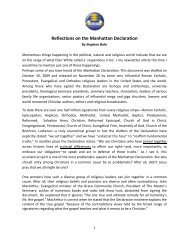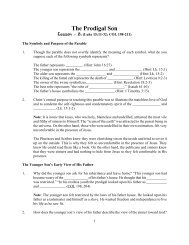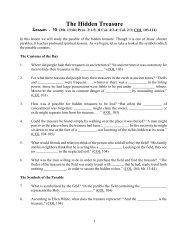The Wheat and the Tares - Secrets Unsealed > Home
The Wheat and the Tares - Secrets Unsealed > Home
The Wheat and the Tares - Secrets Unsealed > Home
Create successful ePaper yourself
Turn your PDF publications into a flip-book with our unique Google optimized e-Paper software.
5. What does <strong>the</strong> good seed symbolize? “<strong>the</strong> good seed are <strong>the</strong> children of <strong>the</strong> _____________”<br />
(Mt. 13:38)<br />
6. What do <strong>the</strong> tares represent? “<strong>the</strong> tares are <strong>the</strong> children of <strong>the</strong> ____________ one” (Mt. 13:38)<br />
Note: <strong>The</strong> Greek work for tares here is zizania. <strong>The</strong> reference here is probably to <strong>the</strong> lolium<br />
temulentum. “This common Palestinian plant grows about 2 ft. tall. In its earlier stages it is<br />
indistinguishable from wheat. Only when <strong>the</strong> plant matures <strong>and</strong> <strong>the</strong> seeds of <strong>the</strong> darnel turn<br />
black is it easy to tell <strong>the</strong> difference. <strong>The</strong>se seeds are poisonous, <strong>and</strong> if eaten, produce violent<br />
nausea, diarrhea, convulsions, <strong>and</strong> sometimes death.” (<strong>The</strong> Seventh-Day Adventist Bible<br />
Commentary, volume 5, p. 407).<br />
7. <strong>The</strong> tares more specifically represent false believers in <strong>the</strong> church: “By bringing into <strong>the</strong><br />
_____________ those who bear Christ’s ___________ while <strong>the</strong>y deny his _____________, <strong>the</strong><br />
wicked one causes that God shall be dishonored, <strong>the</strong> work of salvation misrepresented, <strong>and</strong><br />
souls imperiled.” (COL 71)<br />
8. Who is <strong>the</strong> enemy who sowed <strong>the</strong> tares? “<strong>the</strong> enemy that sowed <strong>the</strong>m [<strong>the</strong> tares] is <strong>the</strong><br />
_______________.” (Mt. 13:39)<br />
Note: <strong>The</strong> enemy’s sowing of tares was an act of revenge: “In <strong>the</strong> East, men sometimes took<br />
revenge upon an enemy by strewing his newly sown fields with <strong>the</strong> seeds of some noxious weed<br />
that, while growing, closely resembled wheat. Springing up with <strong>the</strong> wheat, it injured <strong>the</strong> crop<br />
<strong>and</strong> brought trouble <strong>and</strong> loss to <strong>the</strong> owner of <strong>the</strong> field. So it is from enmity to Christ that Satan<br />
scatters his evil seed among <strong>the</strong> good grains of <strong>the</strong> kingdom.” (COL 71).<br />
9. When does <strong>the</strong> harvest occur? “<strong>the</strong> harvest is <strong>the</strong> end of <strong>the</strong> ____________.” (Mt. 13:39)<br />
Note: In Greek <strong>the</strong>re are two main words which are translated in <strong>the</strong> King James Version as<br />
“world”. <strong>The</strong> first is kosmos which refers to <strong>the</strong> world in its material composition. <strong>The</strong> second is<br />
<strong>the</strong> word aeon which describes <strong>the</strong> world within its temporal framework. <strong>The</strong> word which is<br />
used in Mt. 13:39 is aeon <strong>and</strong> a better translation of it would be “<strong>the</strong> end of <strong>the</strong> age” (see also,<br />
Mt. 28:20 where <strong>the</strong> same word is used. Ellen White remarks:<br />
“<strong>The</strong> tares <strong>and</strong> <strong>the</strong> wheat are to grow toge<strong>the</strong>r until <strong>the</strong> harvest; <strong>and</strong> <strong>the</strong> harvest is <strong>the</strong> end of<br />
probationary time.” (COL 72).<br />
10. Who are <strong>the</strong> reapers of <strong>the</strong> parable? “<strong>the</strong> reapers are <strong>the</strong> _______________.” (Mt. 13:39)<br />
11. Thought question: Although Jesus did not directly interpret who <strong>the</strong> servants represent, who do<br />
you suppose <strong>the</strong>y symbolize? __________________________________________________<br />
2


